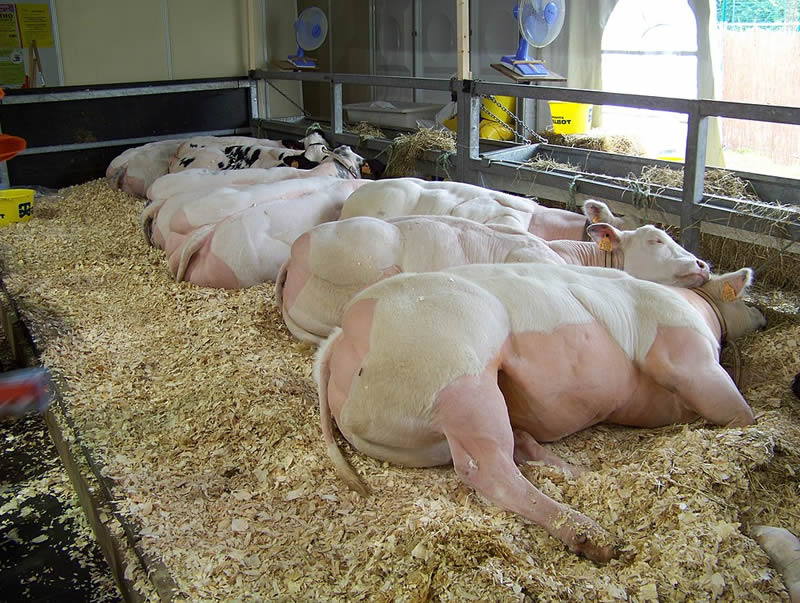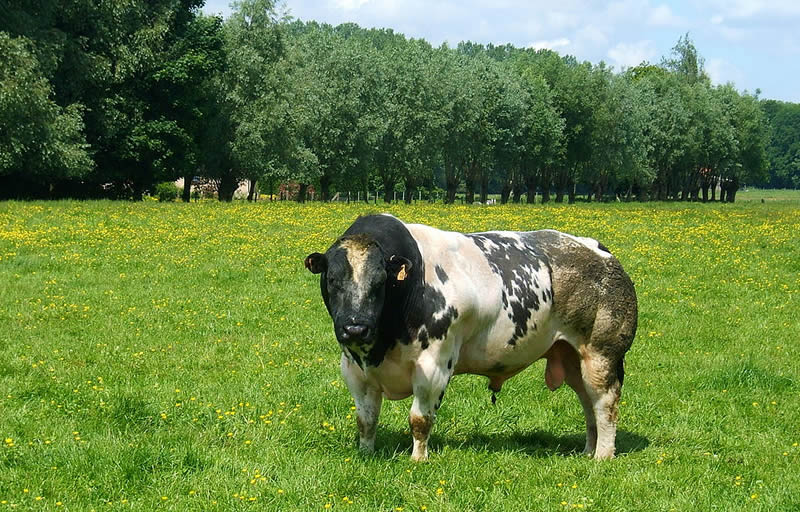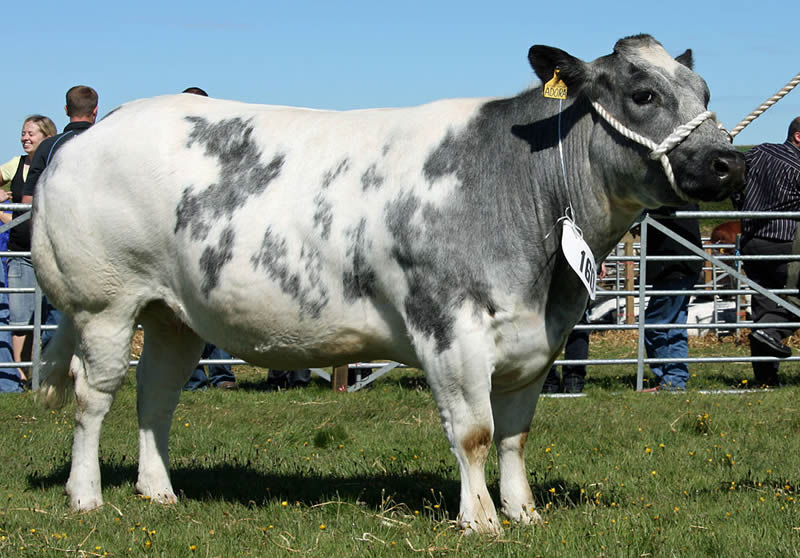The Belgian Blue cow is a controversial animal due to its eccentric history marked by genetic modification and physical appearance. Also known as Race de la Moyenne et Haute Belgique, Belgian Blue-White, Belgian White, and Belgian White Blue, this cow breed is defined by its massive and muscular body.
This breed is suitable for farmers who want to obtain large quantities of meat of superior quality.
In this article, we will present the history of the Belgian Blue cow, the way it should be raised and maintained, but also the less pleasant parts such as the difficulties encountered in raising this breed as well as its health problems.
Contents
Origin & History
The Belgian Blue cow’s history begins in the 19th century when in the center and in the upper part of Belgium, farmers began to develop a special breed of cows. The farmers crossed the local breeds with the English breed of cattle called Shorthorn and with the French breed of cattle called Charolais. The Belgian Blue cow from those times was raised by Belgian farmers for its milk and meat.

In 1950, the work of Belgian farmers was continued and improved by Hanset. Professor at the center of artificial insemination in the province of Liège, Hanset succeeded after many attempts to create the modern breed of Belgian Blue cow. This accomplishment was made possible by the repeated breeding of the animal until the characteristic genetic mutation was fixed in the Belgian Blue breed as its property. The fixed genetic mutation of this genetically modified cow breed is the increased muscle development in some areas of the body as the hips, back, and shoulders.
Belgian Blue cows have on average up to 20% more muscles than beef cattle.
In 1978, the Belgian Blue cow spread outside of Belgium, reaching the United States of America. It was introduced to America that year by Nick Tutt, a Canadian farmer who had emigrated to Texas. After that year, this breed was exported to many parts of the world.
Currently, the Belgian Blue cow is presented in 24 countries from Europe, America, Africa, and Oceania. In 2022, 10 of the 24 countries reported their Belgian Blue cow population, which was 107,875.
Belgian Blue cow – Characteristics
The Belgian Blue cow is a peaceful, calm, and quiet animal despite its absolutely terrifying appearance that is characterized mainly by its huge size and extremely pronounced muscles. The highly developed musculature comes from the mutation suffered in 1978. Then the myostatin gene of this breed of cows was modified.
Myostatin is a protein responsible for inhibiting muscle development. Muscle growth accelerates because the myostatin gene no longer functions normally and can no longer inhibit muscle growth after a certain period. This process of accelerating muscle growth is called hyperplasia.

This genetic modification has not only influenced muscle development, but also fat deposition so that the Belgian Blue cow has a small percentage of body fat.
Furthermore, the genetic modification also affects the fetus from the first months of pregnancy, more specifically from the embryonic stage. A Belgian Blue calf is twice as heavy as a normal calf at birth.
Returning to the appearance of the Belgian Blue cow, it has a rounded body, strong legs, and smooth skin. It can be found in colors such as white, roan blue, and black.
The weight of a Belgian Blue cow varies between sexes. A Belgian Blue bull can reach a weight of 2,645-2,866 lbs (1,200-1,300 kg) and a height of 4,85 ft (148 cm), while females can weigh up to 1,643-1,763 lbs(750-800 kg) and reach a height of 4,33 ft (132 cm).
As for the calves, a male calf can weigh up to 103 lbs (47 kg) at birth, while a female calf can have a weight of around 97 lbs (44 kg).

Breeding Issues
From the point of view of reproduction, this breed of cows has several problems. The first is that Belgian Blue cows suffer from a defect called dystocia. They cannot give birth to calves naturally because they have a narrower birth canal. That’s why Belgian Blue cows only give birth by cesarean section. Cesarean section procedures that influenced the continuation of the birth of double-muscled calves appeared in the 1950s. In general, a Belgian Blue cow can endure around 5-6 births throughout their life.

A second problem that affects the reproduction of the Belgian Blue breed is present in the male. The Belgian Blue bull has a testicular weight and a smaller amount of sperm than other cattle. Also, the quality of the sperm is not very good. But, compared to the problem of females, the bulls’ condition is much more insignificant.
Health Problems
Belgian Blue cows have some health problems characteristic of their breed. These diseases are present both in adult cows and in calves.
Belgian Blue calves can sometimes suffer from a disease called macroglossia which is the swelling or over-extension of the tongue. This malformation will prevent the calf’s ability to feed itself, and as a consequence, it will not survive very long.
Another disease specific to calves is the so-called prognathism, which also affects their feeding. Prognathism is characterized by a shorter upper jaw and a longer mandible. Belgian Blue calves are also more prone than other cattle to laryngitis and bronchopneumonia and are at risk of dying shortly after birth.
Both calves and adult Belgian Blue cows can suffer from heart problems that decrease the chances of survival.
Furthermore, due to their massive body, Belgian Blue cows have limb problems, especially with joints that tend to become stiff, causing difficulty in lifting. The disease cannot be prevented because it develops during the second stage of pregnancy when the fetus does not have enough space to move due to its larger size.

How to Take Care of Belgian Blue Cow
Like many other cattle, Belgian Blue cows need certain conditions to live healthily and reproduce. These conditions include feeding, daily care, and shelter.
Housing
The Belgian Blue cows need shelter during bad weather conditions as well as cold weather. The shelter can be made of any material, both concrete, and wood. The most important thing is that it offers comfort and security to the cows. Preferably, the temperature of the shelter must be between 68 to 79°F (20 to 26° C). It is also good to put animal straws on the floor with a height of up to 16 in (40 cm).
You have to take the fact that Belgian Blue cows are much bigger, so you have to calculate the size of the shelter according to your total number of cows. Each cow must have its own space.
Don’t forget to install a good ventilation system. This will provide clean air to the cows permanently.
Breeding
The Belgian Blue cattle reproduce easily if you have the right ratio of bulls and females in your herd. The Belgian Blue cow can give birth to its first calf between 28 and 35 months.
As with any other cattle, to obtain a high percentage of fecundity, it is very important to mount or inseminate the cows at the optimal time, which is 16-18 hours after the onset of heat.
If mating does not give results, you can try artificial insemination. Only in Belgium, 50% of cows are bred via this method.
Feeding
The quantity and quality of food ingested by Belgian Blue cows are of particular importance because it determines the production of meat that you will get in the end. Do not forget the importance of water in a farm. Cows must have access to plenty of fresh and clean water.
| Feed Type | Feed rate in the dry period of a pregnant cow in the winter | Feed rate in the dry period of a pregnant cow in the summer | Feed rate for a dairy cow in winter | Feed rate for a dairy cow in summer |
|---|---|---|---|---|
| Succulent grass: | – | 155 lbs (70 kg) | – | 220 lbs (100 kg) |
| Hay: | 13 lbs (6 kg) | – | 26 lbs (12 kg) | – |
| Silage: | 26 lbs (12 kg) | 17 lbs (8 kg) | 66 lbs (30 kg) | 17 lbs (8 kg) |
| Haylage: | 17 lbs (8 kg) | 11 lbs (5 kg) | 15 lbs (7 kg) | 11 lbs (5 kg) |
| Straw: | 4.5 lbs (2 kg) | – | 6.6 lbs (3 kg) | – |
| Roots: | 26 lbs (12 kg) | 17 lbs (8 kg) | 39 lbs (18 kg) | 17 lbs (8 kg) |
| Vegetables: | 15.4 lbs (7 kg) | 17 lbs (8 kg) | 13 lbs (6 kg) | 22 lbs (10 kg) |
| Bran: | 4.5 lbs (2 kg) | 2.2 lbs (1 kg) | 1.3 lbs (0.6 kg) | 2.2 lbs (1 kg) |
| Compound feed: | 11 lbs (5 kg) | 8.8 lbs (4 kg) | 11 lbs (5 kg) | 8.8 lbs (4 kg) |
| Concentrates: | 8.8 lbs (4 kg) | 4.5 lbs (2 kg) | 6.6 lbs (3 kg) | 4.5 lbs (2 kg) |
Caring
In order to develop harmoniously, Belgian Blue cows need a clean environment, good food, fresh water, deworming, and regular checks by a veterinarian.
What to Feed The Belgian Blue Cow
Belgian Blue cows love to eat fresh grass, so it would be ideal to have a larger piece of land available to satisfy this need. Except for grass, they can be fed with hay, silage, straw, beets, bran, and various vegetables.
To ensure the necessary vitamins and minerals for good development, you can add various food additives such as bone meal or tricalcium to their food. Salt can also be offered, but it must not exceed 0.15 lbs (70 grams) per day.
Advantages & Disadvantages
| Advantages | Disadvantages |
|
|
Productivity
In terms of productivity, the Belgian Blue cow will not disappoint you. Due to its massive body, it also has a larger carcass than cattle in general. Only the carcass of the Belgian Blue cow contains a percentage of 80% meat, not to mention the other parts of the body.
The meat of the Belgian Blue cow is very healthy due to its low-fat content. And not only that. It is delicious and soft. It is a perfect choice for people who follow or prefer a low-fat diet.
Conclusion
The Belgian Blue cow is an excellent breed in terms of docile temperament, productivity, and the quantity and quality of meat obtained. However, the Belgian Blue cow is not suitable for a beginner farmer due to difficulties such as breeding issues and high maintenance.
FAQ – Belgian Blue Cow
Belgian Blue cows are genetically modified. The genetic modification of Belgian blue cows took place in 1950 and was made by Hanset who was a professor at the center of artificial insemination in the province of Liège. The modified gene is called myostatin, which generally has the function of inhibiting muscle growth.
The meat of the Belgian Blue cow has 157 calories per 3,5 oz (100 g). Its meat is lean and with low-fat content, extremely tasty and delicious.
Belgian blue cows are muscular due to the genetic modification that they underwent in the 1950s. Professor Hanset genetically modified the gene called myostatin, which generally has the function of inhibiting muscle growth. However, after the genetic modification, the myostatin gene no longer functioned at the normal capacity in Belgian blue cows and muscle growth could no longer be stopped by myostatin. As a result, Belgian Blue cows are very muscular.
The meat of the Belgian Blue cow has 157 calories per 3,5 oz (100 g). Its meat is lean and with low-fat content, extremely tasty and delicious.
Belgian blue cows are used in the meat industry. Due to their size and high-quality meat, Belgian Blue cows are suitable for meat production. Also, it is used in milk production too, but much less compared with the meat business.
The Belgian Blue bull’s price can start around $360 and go up to $2,000.
The Belgian Blue bull’s weight is usually around 2,645-2,866 lbs (1,200-1,300 kg). He is visibly much bigger than the female both in terms of weight and height.
Related videos:


Hi
Just wondering when this article was written?
Thank you.
Hi Linus,
I sent you an email.